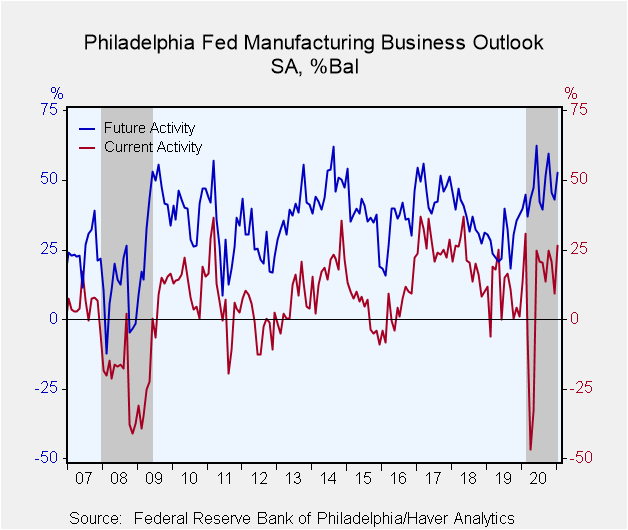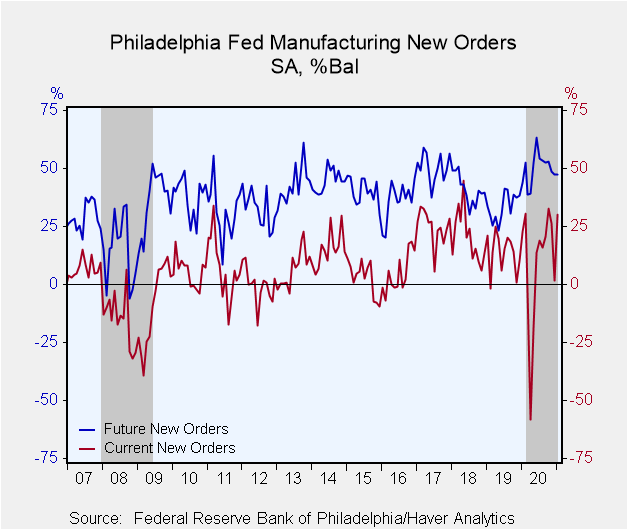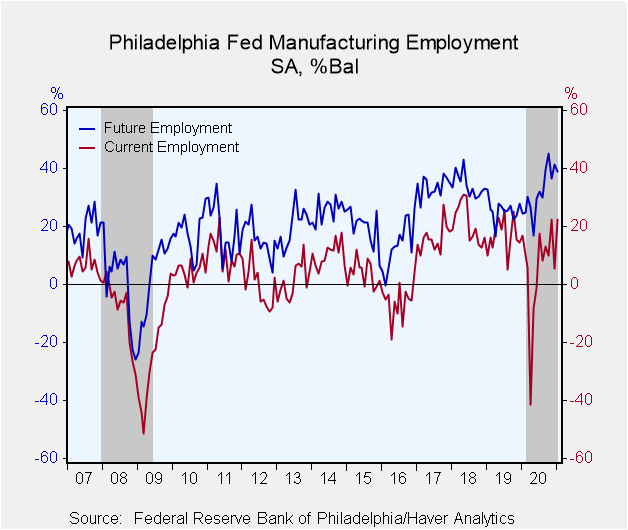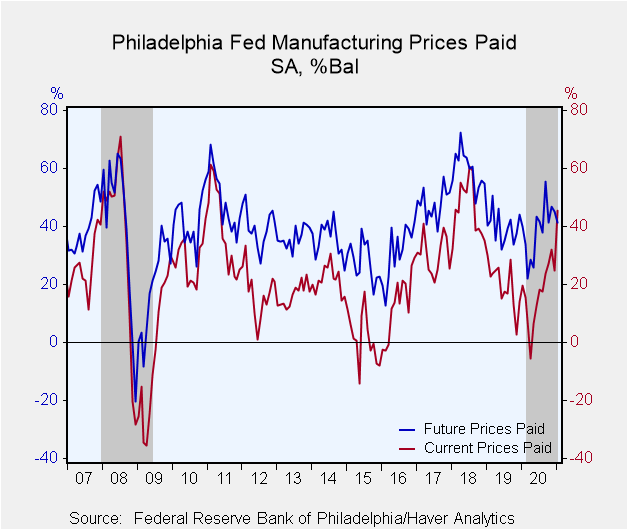 Global| Jan 21 2021
Global| Jan 21 2021Philadelphia Fed Manufacturing Index Jumps in January
Summary
• Headline index rebounds in January; strongest reading since February 2020. • All sub-indices rise, most notably new orders. • ISM-adjusted index tops 60, highest since May 2018. The Federal Reserve Bank of Philadelphia Factory [...]
• Headline index rebounds in January; strongest reading since February 2020.
• All sub-indices rise, most notably new orders.
• ISM-adjusted index tops 60, highest since May 2018.
The Federal Reserve Bank of Philadelphia Factory Sector Business Conditions Index jumped to January to 26.5 after falling to 9.1 in December. While the index has been in positive territory since June, indicating business expansion, the overall measure is at its highest level since the pre-COVID February 2020 reading. The Action Economics Forecast Survey expected 12.0. The percentage of firms reporting improving conditions rose to 39.5% from 28.9%, while the share reporting weaker conditions fell to 13.0% from 19.8%. Haver Analytics calculates an ISM-Adjusted General Business Conditions Index using the same underlying components that comprise the national ISM index. This measure increased to 61.2, the highest reading since May 2018, which was the previous cyclical peak.
All sub-indices rose, led by new orders which rebounded to 30.0 in January from 1.9, though it is still below the October 2020 reading. The employment index improved to 22.5, the highest reading since October 2019. The index of prices paid jumped to 45.4 in January, a level not seen since August 2018.
The Philadelphia Fed also surveys expectations for business activity in six months. The Future Activity Index strengthened to 52.8 in January, though it was 59.5 in September 2020. Sub-indices were mixed with new orders unchanged ,and shipments and employment down.
The survey panel consists of 150 manufacturing companies in the third Federal Reserve District (which consists of southeastern Pennsylvania, southern New Jersey and Delaware). The diffusion indexes represent the percentage of respondents indicating an increase minus the percentage indicating a decrease in activity. The ISM-adjusted figure, calculated by Haver Analytics, is the average of five diffusion indexes: new orders, shipments, employment, delivery times and inventories with equal weights (20% each). Each ISM-adjusted index is the sum of the percent responding "higher" and one-half of the percent responding "no change."
The figures from the Philadelphia Federal Reserve dating back to 1968 can be found in Haver's SURVEYS database. The expectation from the Action Economics Forecast Survey is available in AS1REPNA.
| Philadelphia Fed - Manufacturing Business Outlook Survey (%, SA) | Jan | Dec | Nov | Jan'20 | 2020 | 2019 | 2018 |
|---|---|---|---|---|---|---|---|
| General Factory Sector Business Conditions | 26.5 | 9.1 | 20.7 | 13.7 | 7.7 | 9.6 | 20.7 |
| ISM-Adjusted Business Conditions | 61.2 | 53.5 | 57.3 | 54.9 | 52.2 | 55.4 | 57.6 |
| New Orders | 30.0 | 1.9 | 26.1 | 23.0 | 8.6 | 13.7 | 20.6 |
| Shipments | 22.7 | 12.0 | 18.2 | 21.4 | 9.6 | 16.6 | 22.6 |
| Unfilled Orders | 25.6 | -0.1 | 17.6 | -1.2 | 0.3 | 7.6 | 6.9 |
| Delivery Time | 30.0 | 17.3 | 14.6 | 0.8 | 5.1 | 9.4 | 9.5 |
| Inventories | 12.6 | 7.7 | 0.4 | -2.0 | -0.2 | 5.0 | 7.3 |
| Number of Employees | 22.5 | 5.6 | 22.3 | 16.9 | 4.9 | 16.8 | 21.3 |
| Average Workweek | 18.6 | 15.5 | 22.4 | 3.6 | 4.3 | 9.7 | 15.8 |
| Prices Paid | 45.4 | 24.9 | 32.0 | 19.5 | 16.7 | 19.6 | 46.1 |
| Expectations - General Business Conditions; Six Months Ahead | 52.8 | 43.1 | 45.6 | 39.6 | 46.3 | 28.4 | 36.8 |
Gerald D. Cohen
AuthorMore in Author Profile »Gerald Cohen provides strategic vision and leadership of the translational economic research and policy initiatives at the Kenan Institute of Private Enterprise.
He has worked in both the public and private sectors focusing on the intersection between financial markets and economic fundamentals. He was a Senior Economist at Haver Analytics from January 2019 to February 2021. During the Obama Administration Gerald was Deputy Assistant Secretary for Macroeconomic Analysis at the U.S. Department of Treasury where he helped formulate and evaluate the impact of policy proposals on the U.S. economy. Prior to Treasury, he co-managed a global macro fund at Ziff Brothers Investments.
Gerald holds a bachelor’s of science from the Massachusetts Institute of Technology and a Ph.D. in Economics from Harvard University and is a contributing author to 30-Second Money as well as a co-author of Political Cycles and the Macroeconomy.









